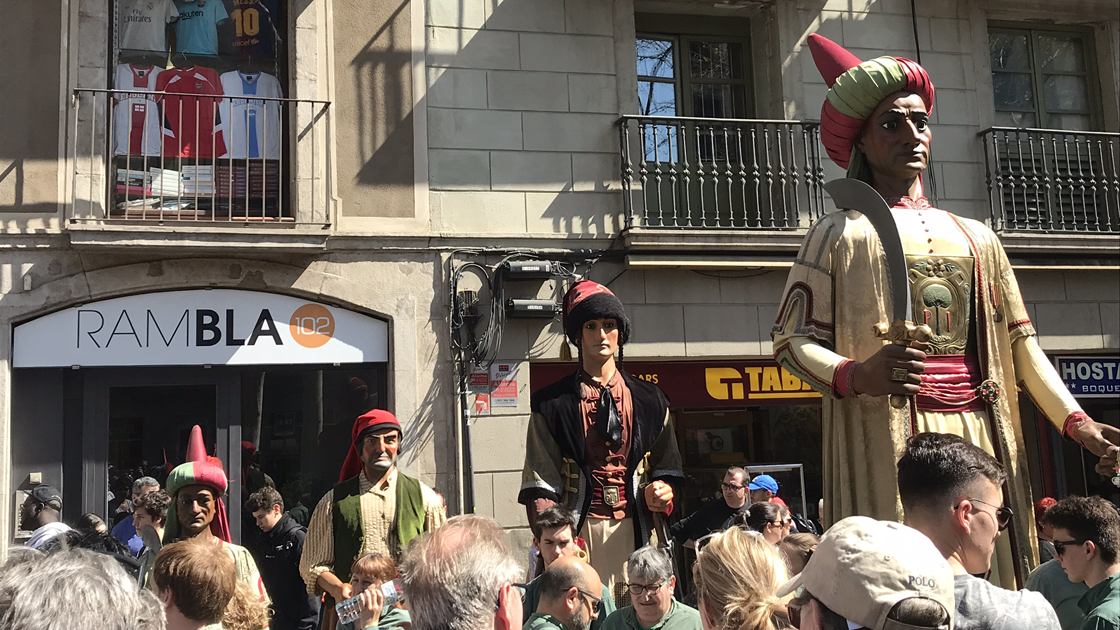
TOURING CATALONIA IN THE COMPANY OF DANCING GIANTS… AWESOME!
What if you were invited to follow 4-meter (12-foot) tall dancing giants around Barcelona and Catalonia? Would you be frightened, or excited?
Don’t be scared! Our giants are nothing more than huge puppets, and watching them parade through the streets of Catalan towns is one of the most beautiful experiences you can have here.

A tradition dating back to the middle ages
The tradition of giants in Iberia dates back to the middle ages. The earliest recorded mention of giants is in Evora, Portugal in the 13th century, followed not long after by an appearance in Pamplona, Navarre.
From there the tradition spread to Castile and especially to the territories of the Crown of Aragón, to which Catalonia belonged in the olden days.
The giants of Catalonia
In Catalonia the presence of Giants at religious feasts has been recorded as early as the 14-century. By the 19th century they had become a strong element of the local identity.
The tradition remains very much alive today, thanks to the enthusiasm of the local civil society. The activities of the many Giant groups or colles de geganters are coordinated under the Agrupació de colles de geganters de Catalunya, a Catalan federation of colles.
Religious feasts and other local festivities often feature a Ball de Gegants, or Giant’s dance.

What’s a giant like?
Giants are very tall figures, hollow inside and with paper-maché head and arms. They are clothed in material shaped like traditional robes and garments.
Their frame is generally made of wood, and an individual controls them from the inside during the dance.
Who do giants represent?
Giants normally represent historical kings and queens and nobles, but also archetypal fishermen, farmers and even infamous historical figures such as 17th-century bandit Perot lo Lladre.

How does a giant awaken?
In order to animate a giant, an individual must be capable of not only shouldering the weight, but also maneuvering it at the same time using a harness strapped to their shoulders.
When the person inside moves, the giant awakens and starts shaking in a dance.
Giants are very heavy to carry! That’s why members of a giants association take it in turns to carry the figures during a parade, normally for not more than a few minutes at a time.

Dancing in good company
Such dances are normally performed by a couple: a male giant and a female giantess.
Most Catalan towns have at least a pair of giants, though many have more, and Barcelona has scores of them!
Capgrossos
Capgrossos are smaller human figures with exaggeratedly oversized paper-maché heads. They look a little grotesque and are very funny.
While giants symbolize majesty and solemnity, capgrossos add a touch of extravagance to the parade as they bounce around, cutting a chaotic path through the procession.
Fantastic beasts and monsters
Besides human-shaped figures, there’s a host of others that seem to have come out of a medieval bestiary.
Some of them are traditional symbols of the evil that must be defeated. Imagine terrible sea monsters, dragons, griffins and even demons like Tolc, the “beast” of the Clot neighborhood of Barcelona.
The giants and Barcelona’s city feasts
We love to see them dance along the Ramblas of Barcelona and the streets of the old town, accompanied by a marching band.
The city’s most important feasts, or festes majors, of La Mercè (September) and Santa Eulàlia (February) are a great moment to be in town if you are interested in the local popular traditions.
Other local feasts where giants can be seen in Barcelona are the Feasts of Gràcia (August) and the Festa Major of Clot (November), to name just two.

Would you like to know more about giants?
Loved this post and want to know more? Contact us!

Magnifico poster e poter assistere a questo spettacolo bellissima esperienza!!!
My favourite giant is “el gegant del Pi” with his customized song.
Correct! A song just for the gegant del Pi!
El gegant del pi
Ara balla ara balla
El gegant del pi
Ara balla pel camí
El gegant de la ciutat
Ara balla ara balla
El gegant de la ciutat
Ara balla pel terrat
Soon it will be possible again!
Presto sarà di nuovo possibile!
These giants are beautifully dressed. I bet adults and children alike want to see the Giants dances. I wonder though whether Barcelona gets even more crowded during Feasts of Gràcia and the Festa Major of Clot.
Hi Denise!
These feasts are especially beloved by locals but they are open to all those who want to enjoy the atmosphere of celebration!
The Clot feast is celebrated in November and normally not so many tourists are in Barcelona during that time of the year.
As for Gràcias feasts, it’s true that usually there’s many tourists in Barcelona in August.
However, no so many come specifically for the feasts, but are very happy to join the big parties in the streets of Gràcia once they hear of them in Barcelona.
In general both children and adults like giants. Children like them because they are children, and adults because… they were children and still are children, in a corner of their hearts!
I’ll come sometime, sure. Looking forward….
Welcome! We’ll be happy to show you the city and the rest of Spain! … and Portugal!